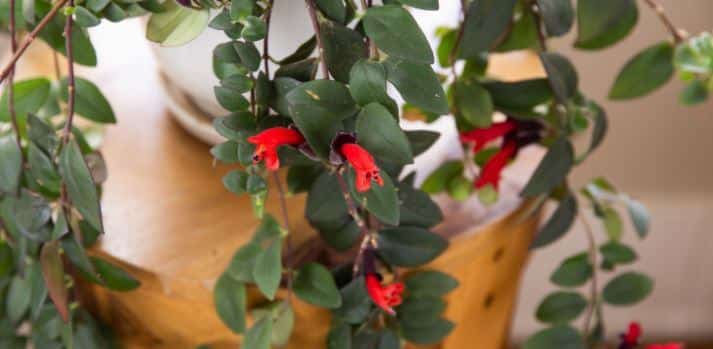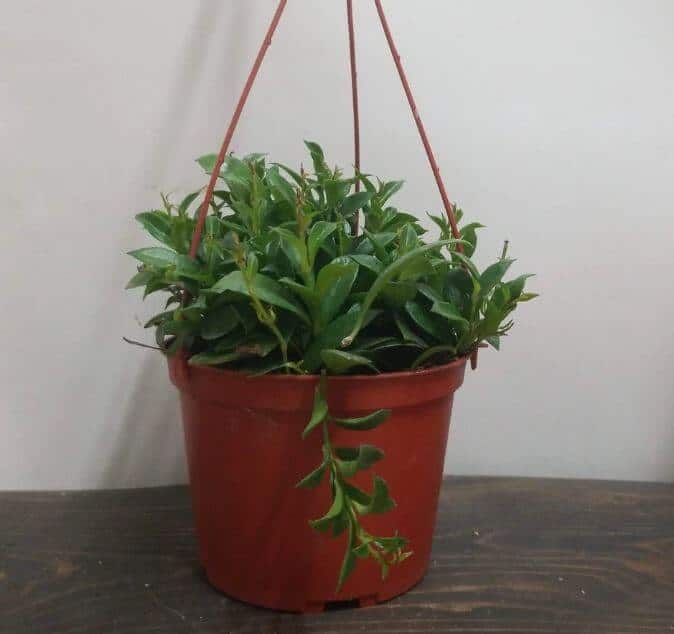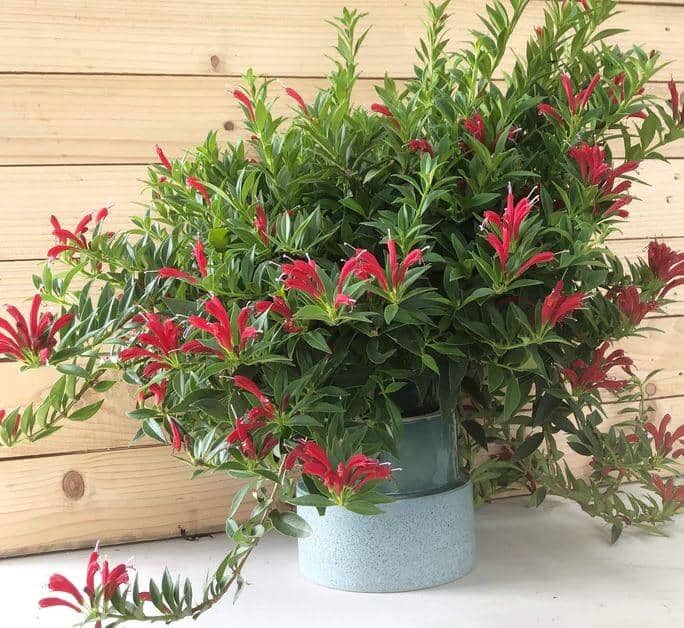Last Updated on January 6, 2023 by a Friendly Gardener
The purple star lipstick plant may sound a little bit like a diva, but this unique, gorgeous plant is surprisingly low maintenance!
With the right care, these plants can reward you with splendid blooms and foliage and look great when hung from a basket or allowed to cascade over a shelf or pillar.
What is the right care, though?
Well, here’s a handy guide to help you out with purple star lipstick plant care, while giving you a low down on this unique plant!
About the Purple Star Lipstick Plant

Scientifically known as the Aeschynanthus radicans and colloquially known as basket vine, lipstick purple star plant, and lipstick plant purple star, the purple star lipstick plant is a tropical flowering epiphyte that hails from Southeast Asia’s tropical stretches.
The plant earns its name from its unique flower buds, which resemble lipstick tubes. As the flower emerges from the bud, it looks like lipstick coming out of the tube!
The purple star lipstick plant belongs to the Gesneriaceae family’s Aeschynanthus genus, which is made up of around 150 evergreen tropical and subtropical species of plants. Most of these species, like the purple star lipstick plant, are trailing epiphytes with bright blooms.
All species of the Aeschynanthus genus are commonly referred to as lipstick plants, but there are several standout varieties apart from the purple star lipstick plant, such as the black pagoda, Mona Lisa, curly leaf, the twisted lipstick plant, and the rare variegated variety.
Coming back to the purple star lipstick plant, you can expect blooms between summer and fall in shades of orange, red, yellow, and burgundy, and green, leathery leaves that can grow up to eight centimeters (around three inches). The plant itself can reach a maximum height of 1.5 meters.
Though purple star lipstick plants are natural epiphytes, you can grow them in the ground or in containers indoors and outdoors.
Lipstick plants lack hardiness and only thrive in USDA hardiness zone 11, where it’s warm throughout the year.
Purple Star Lipstick Plant Care

Here’s how to care for your purple star lipstick plant.
Growing Spot
As mentioned earlier, lipstick plants can flourish both indoors and outdoors. If you’re growing them indoors, do so in well-draining soil and pots and place them in a spot with filtered, bright sunlight.
If you’re growing them outdoors, plant them in a spot with partial shade. If winter temperatures drop below 60℉, you’ll need to bring the plants indoors.
Watering Requirements
Lipstick plants are not fans of water; they’re drought-tolerant plants that are extremely sensitive to overwatering. Having said that, the soil around your lipstick plant should never be allowed to dry out completely.
Your plant’s leaf health will tell you if it’s receiving sufficient water. Dehydrated lipstick plants will start losing their leaves, which turn brown and drop off when they receive insufficient water, and turn yellow and drop off when they receive excessive water.
Another way to check if your plant is receiving sufficient water is to check the soil’s moisture levels. The top few inches of the soil and the root ball must always stay moist; they shouldn’t dry out completely nor should they be wet.
A soil moisture gauge is also a great idea.
Until you get the hang of things, it’s always prudent to check the soil’s moisture level before you water the plant, to prevent overwatering and root rot.
Light Requirements

Lipstick plants are tropical plants that love bright, filtered/indirect sunlight and bloom best in such light conditions. Ideally, they should receive such light throughout the year; if you don’t receive such sunlight, consider getting grow lights.
If your plant isn’t getting sufficient sunlight, there will be no blooms; if it’s getting too much sunlight, there’s a possibility of the foliage burning.
For outdoor lipstick plants, a partially or fully shaded spot will work best.
Humidity Requirements
Purple star lipstick plants require humidity between 50% and 60%, which is why they do well in kitchens and bathrooms.
If the air isn’t humid enough, there are several ways to increase its humidity levels, such as using pebble trays and humidifiers, misting the leaves, and grouping plants.
Temperature Requirements
Purple star lipstick plants thrive in temperatures consistently sitting between 65℉ and 85℉. While they can survive the occasional, short exposure to temperatures as low as 40℉, prolonged exposure to temperatures not in the aforementioned range will harm the plant, causing growth to stop, leaves to drop, and even death.
Similarly, purple star lipstick plants shouldn’t be exposed to temperatures above 100℉. In case you see such temperatures in your region, protect your plant by placing it in full shade and increasing the humidity level.
Soil Requirements
Lipstick plants do just fine in general potting mixes. To be on the safe side and prevent overwatering, you can consider adding materials such as pumice, perlite, and coarse sand to the potting mix to improve drainage.
African violet mixes and other fast-draining mixes also work well.
Fertilizing Requirements
If you’re fertilizing your plant, do so in its growing months—spring to summer. Organic fertilizers, compost, and slow-release granules are all great options.
Using a fertilizer will encourage better foliage growth and blooming.
Repotting, Pruning, and Propagating

Purple star lipstick plants are one of the few that flourish when they’re root-bound, producing better blooms. Therefore, only repot your lipstick plant when it’s necessary, such as when you see the roots growing out of the drainage holes.
In such a case, repot in a pot that’s one size bigger.
Pruning during spring and summer, right after the plant blooms, helps encourage fuller growth but is not a necessity.
When it comes to propagating, stem cuttings and divisions work best; seed propagation is extremely slow and can be quite touch-and-go.
If you’re using a stem cutting, using a propagation chamber and rooting hormone will help in faster growth and development.
The Bottom Line

To add to its appeal, a well-cared-for purple star lipstick plant doesn’t suffer any pest and disease problems apart from the usual spider mites, aphids, and mealybugs. These can be easily treated with insecticidal soap or neem oil.
They’re also not toxic to pets or humans—more brownie points!
With so many things working in its favor, a purple star lipstick plant is among the best household plant options, so don’t hesitate to go for it!

